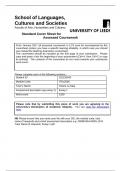School of Languages,
Cultures and Societies
Faculty of Arts, Humanities and Cultures
Standard Cover Sheet for
Assessed Coursework
From January 2017 all assessed coursework in LCS must be accompanied by this
coversheet (unless you have a specific learning disability, in which case you should
use instead the Marking Awareness coversheet).
This coversheet should be included as the first page of your submission. Please
copy and paste it into the beginning of your assessment (Ctrl+A, then Ctrl+C to copy
its entirety). The contents of the coversheet do not count towards your submission
word count.
Please complete each of the following sections:-
Student ID: 201226943
Module Code: ITAL2026
Tutor’s Name: Chiara La Sala
Assessment description (eg essay 1): Essay 1
Word count 2180
Please note that by submitting this piece of work you are agreeing to the
University’s Declaration of Academic Integrity. You can read the Declaration
here.
NB Please ensure that you name your file with your SID, the module code, tutor
name (if required) and a brief assessment description e.g. 200987654 MODL1234
Tutor Name (if required) Essay 1.pdf
, ‘During the 1950s and 1960s the national language came to be adopted more
and more widely throughout Italy, not only as a written language, but also as a
spoken one’ (Arturo Tosi). Explain why this spread took place in this period
and describe in what ways modern standard Italian has come to differ from the
language regarded as the norm before the 1950s.
The diachronic development of the Italian language has been a poignant debate for
centuries and came to be known as the ‘questione della lingua’.1 However, the
process of forming a national language, as well as the way in which it was spread
throughout the country, was a complex process due to social and political factors
which hindered its evolution. Therefore ‘the linguistic differences that we find in
Italian society today is evidence of the heritage of many centuries of political division
and cultural diversity’2. This was why the national language as both a written and
spoken form only came to be adopted predominantly from the 1950s onwards. There
were various factors which contributed to this development and change in the
linguistic dynamic of Italy, however the most notable include the period of
industrialisation and modernisation of the country post World War II, and the rise in
mass media.
The most significant changes happened in the 1950s and 1960s; however, there is a
stark contrast between the situation before and after this period. The situation in Italy
pre-1950 was characterised by linguistic division and illiteracy with the national
language based on the literary standard opposed to that which was used in everyday
conversation. This was firstly the result of political division since Italy became a
unified nation only in 1861. Richardson supports this view by stating that, ‘before the
political unification of Italy, Italian was a language used […] only by the literate few.
Even by these, it was reserved chiefly for writing’. 3 This highlights the fact that Italian
was not suited to the whole population therefore it was almost impossible for it to be
appreciated let alone used in everyday conversation. As a result, the dialects
continued to prevail throughout Italy and blocked the progression of the national
language. Equally the strong regional differences and identities in Italy meant that
even after unification people were reluctant to abandon their mother tongue,
especially as the vast majority of the population were unfamiliar with or had never
come in contact with this standard written language. The dominance of dialects
before and in the years after unification in fact signifies the fact that the national
language was still only an ill-adapted concept. Therefore, as Richardson
emphasises, there was a ‘gulf between everyday reality and what has been
essentially written or second language’.4 These political and social factors therefore
1
Richardson, Brian, ‘Questions of Language’, in The Cambridge Companion to Modern Italian
Culture, ed. by Zygmunt Baranski and Rebecca West (Cambridge: Cambridge University Press, 2001)
pp. 63
2
Tosi, Arturo, Language and Society in a Changing Italy, (Clevedon, Multilingual matters, 2001) p.3
3
Richardson, p. 63
4
Richardson, p. 64




